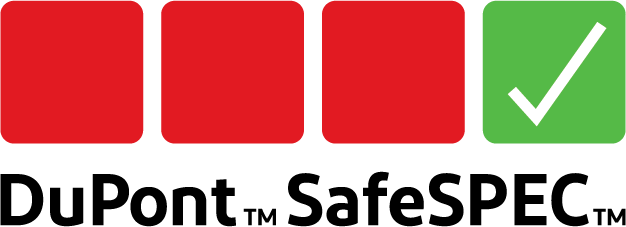Chemical Protection - considerations for PPE when handling hazardous chemicals
The selection of personal protective equipment (PPE) for chemical hazard situations is a complex and daunting task and the number of variable factors can make it a highly difficult and confusing process without expert assistance.
THE NEED FOR SYSTEMATIC RISK ANALYSIS
Chemicals can pose a risk at many stages of their life cycle from initial manufacture through to end use and in some cases for a long time thereafter. The huge spectrum of chemicals used right across industry, agriculture, health and many other sectors renders it particularly difficult to minimise the risks that chemical hazards can present. Used in many different applications, in many different ways and in a huge variety of locations, chemicals present a bewildering scope of potential risk environments ranging from manufacturing installations, laboratories, paint shops and maintenance jobs to nuclear power plants, remediation sites, medical facilities and emergency response situations. Chemicals are also capable of causing harm to humans in several different ways; they can cause injury through direct skin contact, by inhalation of fumes, vapours and dusts and by inadvertent ingestion.
The resulting diversity of application and hazard scenarios makes it essential to undertake a systematic risk analysis when assessing and selecting specialist PPE for chemical protection purposes. It is clearly not sufficient to simply rely on trying to interpret generic industry standards or to just meet 'legal minimums' when selecting chemical PPE. One of the issues here is that there is a huge breadth of protection available within each of the different European PPE performance classifications.
Another issue is that the theoretical level of protection on offer from PPE is rarely, if ever, achieved in practice and the actual degree of protection can be very difficult to ascertain. As a result safety professionals must look beyond these nominal measures and look at the 'whole safety picture' when meeting their legal obligation of taking 'all reasonably practical' steps to protect workers from unnecessary exposures to chemical hazards. This means that, in addition to providing suitable technical protection, safety specifiers must actively take into account factors such as user comfort, user fitting, compatibility of different PPE components, maintenance and storage factors etc. when assessing alternative PPE solutions.
PRECAUTIONS WHEN HANDLING INDUSTRIAL CHEMICALS
If you are unsure what a chemical is, always treat it as hazardous.
- Never use a chemical product that is unlabelled.
- Be aware of the hazards associated with any chemicals you use and know how to use the product safely.
- Never mix or adulterate chemicals unless you know what you are doing and have received the appropriate training.
- Wherever possible consult chemical manufacturer for safety advice and always read the label on chemical products.
- Engage with a reputable supplier when selecting PPE for chemical exposures and always take safety, durability and wearability into account.
SELECTING PPE IS A DAUNTING TASK
PPE is the final line of defence when it comes to protective personnel from chemical hazards. As such it is a critical safety measure that can't be compromised. Nonetheless, PPE is highly prone to being under-specified, over-specified or even wrongly specified resulting in unnecessary risks to personnel and failures due to damage, poor maintenance or misuse.
This makes the selection of chemical protective equipment a complex task. The incorrect specification of protective gear risks putting personnel in danger and at the very least will negatively affect their productivity. To complicate matters, some of the risks that are presented by certain chemicals are not necessarily immediately apparent. The consequences of exposure to certain chemicals can manifest themselves several years down the line, long after the point of encounter.
So great care must be exercised in the specification of suitable workwear against known or anticipated risks. The use of PPE (unless mandatory) must be dictated by the risk assessment for the activity or environment concerned and this must include giving due consideration to the crucial issue of user comfort. PPE that is difficult to don or doff, that is uncomfortable to wear, that curtails movement or unduly restricts work activities will always meet user resistance. Selecting user-acceptable PPE can be every bit as important as, and even more difficult than, selecting the appropriate technical specification.
PPE CLASSIFICATIONS - THEIR ADVANTAGES AND THEIR LIMITATIONS
Protective garment specifiers need to be aware of the limitations of current technical standards. For example, the European CE marking means that chemical protective clothing meets certain minimum requirements and complies with one of the six CEN apparel classifications or 'Types'. However, the broad performance span of the different performance Types means that two protective garments of the same 'Type' can offer very different levels of protection.
Similarly, the EN 'breakthrough' classes, which provide an indication of permeation resistance over time, are measured under laboratory conditions and can only give an indication of performance in practice. It must always be recognised that the theoretical level of protection provided under controlled circumstances can vary significantly from the protection available in real usage conditions and that every hazard exposure, every work activity and every hazardous environment is different. For example different workplace configurations, plant and equipment, work activities, job practices, and individual factors. For these reasons it is essential professional advice is taken when assessing and selecting apparel for hazardous environments.
Furthermore the CEN standard and other classifications pay little, if any, attention to ergonomics and don't provide PPE buyers and specifiers with any indication of how comfortable a piece of equipment is for the wearer.
PREVENTION IS KEY
It must always be remembered that PPE only protects the individual wearer, it does not tackle the cause of the risk exposure. It is important that all possibilities of removing the hazard altogether are exhausted before considering ways of limiting operator exposure. The following 'hazard control hierarchy' can be used as a 'rule-ofthumb' guide to good practice:
- Eliminate - remove the risk altogether if this is at all possible.
- Substitute - find a safer substitute e.g. a less toxic chemical or a different working method.
- Safeguard - put technical solutions in place that protect the worker e.g. mechanical ventilation, machinery guards, remote controls etc.
- Warn and Educate - implement worker training and install suitable alarm and warning systems.
WHOSE RESPONSIBILITY?
It is the responsibility for management to design jobs and plan working methods safely and to reassess jobs and procedures in reply to changing conditions such as the emergence of new hazards. However, the responsibilities do not stop with employers. Employees must be trained and educated to accept responsibility for identifying risk situations and for taking the necessary safety precautions. This includes a responsibility for using the PPE provided in the correct manner and being aware of its use, its limitations, its useful life and its correct disposal.
GET THE ANSWERS NOW - GET PROFESSIONAL ADVICE
The optimum choice of PPE requires sound judgement, a sound understanding of hazards faced and a detailed knowledge of personal protection principles, technical standards and equipment performance. Consultation with the PPE manufacturer is essential to understand the protection on offer and to ensure that safety is not compromised. Unless it's a 'repeat order' situation it's not enough to rely on choosing protective coveralls (or any other PPE) from a web-site or a piece of literature without professional guidance. The optimum and safest choice of personal protection requires sound judgement, a detailed understanding of risk and a comprehensive knowledge of personal protection principles, technical standards and equipment performance.
DuPont have a comprehensive range of protective garments and accessories suitable for chemical handling operations including the highly featured Tychem ® 4000S designed for maximum comfort in hazardous environments and the new Tyvek® 800J coverall which offers resistance to oils, particles and pressurised jets of water-based chemicals all in a high comfort, breathable, Type 3 limited-use garment.
DuPont - A GLOBAL LEADER IN PERSONAL PROTECTION
A global leader in personal protection, DuPont has been addressing the world’s safety needs with the best in technologies and innovations for over 40 years. DuPont Personal Protection offers comprehensive support in protective garment selection and chemical risk assessment as well as training on the use of protective clothing. A customised selection service is available for all Tyvek® and Tychem® protective clothing products.



